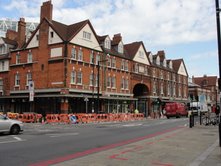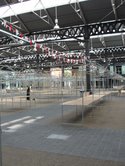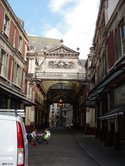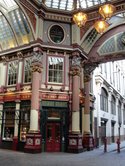August 22nd, 2009 · 1 Comment
Recently I travelled with my class to Greenwich to see the Prime Meridian and other famous sites in the town. Instead of taking the tube, we travelled in style, hopping on a boat that took us down the Thames. As we motored down the river, I was beset on all sides with proof that London is truly a town of ever-changing ideas and time periods. Tall and majestic 17th century churches rode right up against uniform concrete estates. In what once was a warehouse district stoop a massive ziggurat-like structure all consisting of flats with views of the Thames. And in walking distance of Greenwich was the monstrously expensive and ugly birthday cake of the Millennium dome. What was once supposed to be a way to promote development in the surrounding area, the Dome stands surrounded by forlorn construction sites.
Once in Greenwich, the scenery took a turn for the better. Beautiful old houses lined the streets and the incredible sites such as the Maritime Museum, the Queen’s House, and the Astronomy Museum were all in shouting distance of each other. After a short hike up a tall hill in the beautiful Greenwich Park, we stopped at the royal observatory and the Prime Meridian. After the obligatory group photo, we were left to our own devices to explore the nearby museums. It was in the Royal Observatory that I learned a bit of the history of the invention of longitude. Perfected by a British clockmaker, longitude allowed mariners to master sea travel and cartography. It should come as no surprise then that the origin point of longitude, the Prime Meridian, should be at any other place than England. Because the English were the first to discover it, England was able to place itself, more specifically its capital, at the origin of everything. It is simply startling to think that things we take to be true without bias, such as the orientation of maps, can be so heavily influenced by nations attempting to gain influence.
Tags: Paul
We left the Arran House bright and early at 8am. Together, we boarded the tube and set off for East Aldgate in search of the Whitechapel Market. This proved to be much more of a hassle than we had imagined. As we left the station and entered the streets of Whitechapel, our first perception of the area was the large, pristine East London Mosque, featured below.

From that moment on, we observed many bilingual street signs (in Arabic and English) and small family owned businesses including flower shops, restauraunts, and news agents.

Though there were a plethora of shops, there was a distinct lack of people. We were perplexed by the quiet streets and closed stores and were still unable to locate the elusive Whitechapel Market. Thankfully, a mailman was able to calm our fears…by telling us that it did not exist. He instructed us to walk a few blocks to Commercial Street where we could visit Spitalfields, a predominantly Islamic market. This also proved to be a disaster: it was closed, as we later found out from Professor Qualls, due to the beginning of Ramadan. Below are a few pictures of the deserted market which we imagined, under different circumstances, would otherwise be a vibrant and exciting community.

This is the exterior of the Spitalfield Market!

Here is the interior of the deserted market.
After another panicked call to Professor Qualls, he then directed us to Leadenhall Market which we located on the outskirts of London Proper. Originally a market for fish and cheese mongers, it was established in 1321 as a meeting place for vendors. However in 1666, parts of the original building were destroyed by the Great Fire and then later rebuilt in both 1881 and refurbished in 1990.

This is the entrance into the Leadenhall Markets.
Below is an image that captures the amazing architecture of the market place which is clearly incredibly ornate and a far cry from what we saw in Whitechapel. Not only were there high-end retail stores, but also high-rises and the buildings and streets were noticeably cleaner.

Here is an example of Leadenhall Market's interior!
Despite the fact that the markets were closed, it was still a very enlightening experience, for we saw two different Londons. The first being a predominantly immigrant community that combined the traditional culture of their homelands with the western ideals of Britain. The second was a more commercialized section of the city and felt more like a mainstream city center. It lacked, however, the intimate nature of Whitechapel. All in all, this experience helped us realize the economic and cultural diversity of London!
Tags: Kelley · Kimberly · Maddie · Markets
Traveling through the Thames River to Greenwich was a magnificent experience which allowed me to view a city that is not always known to visitors or even individuals living in London. Upon walking to the boarding point I realized that Big Ben was visible from where we were standing and has made me realize that I am actually exploring London. Yesterday’s travels were exciting and new; but I was left feeling that I was just in another big city like New York or Los Angeles. Seeing the landmark of London brought upon me this new recognition. The actual boat ride allowed us to view many parts of the city and get me excited for the rest of the trips that we will make throughout London; however, I have also recognized a new interest for architecture. I have noticed the mixture of structures the first day in London when I traveled to Liverpool Street but it seems that such juxtaposition is all throughout the city and while traveling on the water one can distinguish the historical places that were build centuries ago from modern buildings used by corporations and residential buildings which exuded creativity. Walking in Greenwich has allowed me to set my foot back in time. The structures whether it be the Queen’s House or the metal planks left from the industrial period once again shows a diversity that exists in London where the history has integrated with Victorian and Industrial periods.
Upon leaving the Market that was taking place next to the pub, Anthony, Flow and I decided to take the 188 bus through Elephant and Castle and other neighborhoods back home. I was interested in viewing the class and race differences that exist in Gower Street area and those which exist in Elephant and Castle. The difference was definitely present, not only in skin color but also the stores that occupied the streets and the types of housing that we have discussed previously. Upon getting back to Gower Street, we made a visit to a local technology store where an unexpected conversation took place with local salesmen in which the topic of President Obama and how we feel about him rose up as well as our traveling plans and our feelings about London. Overall, I found them friendly and I loved the British humor that they possessed. I am looking forward to interacting more with the British in London and once we get to Norwich. Later that evening, we once again decided to randomly take a bus and head wherever it would take us. We ended up in Camden Town which is probably my favorite part of the city. Filled with rockers of our age and a mix of Columbian music and small boutiques, Camden Town is a place for leisure.
Tags: Jeyla
I love UNESCO world heritage sites and am thrilled to be able to count Maritime Greenwich among those I have visited! I honestly didn’t know what to expect before going to Greenwich this morning. I knew that there was an observatory, which meant that there was at least one really big hill, and the Prime Meridian, which my mother had requested I take a video of myself dancing on (yes, I did and it’s a long story).
What struck me first at the observatory was the practical elegance of the buildings. The original observatory, designed by Christopher Wren, had a beautifully decorated dome that was perfect for viewing the sky, but it also had the necessary living quarters for the Royal Astronomer. My favorite exhibit in the observatory museum was of the clocks. I found it really interesting to see the progress of clocks over time and the timepieces used in specific jobs to this day (ex. the diver watch and the Underground/Bus driver clock). I didn’t know that wristwatches were seen as feminine before WWI, but were found to be more practical in the trenches, causing men to adapt them.
After lunch, Chelsea and I headed over to the Maritime Museum and spent a fair bit of time wandering around the exhibits. In one of the rooms there was a really neat display that showed Butler’s Wharf (which we passed on the boat) as it was in 1937 and then again in 1997. It was very clear to see the development that happened over that 60 year span. In 1937 it was a heavily worked dock and warehouse area, while in 1997 it had been converted to luxury apartments. That display illustrated the expansion of the upper-middle class city into what had been a very working class area.
One of the other rooms in the Maritime Museum that I found fascinating was the reconstructed stained glass from the Baltic Club. The Baltic Club was a high-end club in the center of London and it was bombed in 1992. This exhibit showed the damage that had been done to the windows and what the conservationists had to do in order to restore them to their original state.
Greenwich Market was a curious place. It had just about everyone and everything you can think of: different languages being spoken, ethnic crafts, clocks made out of vinyl records, jewelry, lots of soap/incense places, and, of course, food. It didn’t take me too long to get through the market, but it was very charming. After the market, Chelsea and I, after much searching and walking, managed to find a 188 bus stop that was not closed for construction. Neither of us had really been on a bus in London, so we figured it was as good a time as any to figure out the system. A very long bus ride later, we got the Russell Square and made our way back to the hotel.
Tags: Kelley · Markets · Museums

Liverpool Station
To arrive at Liverpool Street, we took the red Central tube line from Tottenham Court Street directly to Liverpool Street. On the way to our destination, in the Tottenham Court station, we saw a blues performer. We later learned at these station performers, who are called Buskers, were licensed and had to pay to perform there. Once on the tube, we saw a mix of many different people, mostly on their way to or from work. Since both of us are from New York City and make use of the public transportation often we couldn’t help but to compare the London tube to the New York City subway stations. The tube was definitely more organized with large maps and accessible directions, cleaner and more colorful. Large advertisements and walls decorated with mosaics of musical instruments occupied walls of the tube stations.
It took us about 15 to 20 minutes to reach the Liverpool station, unlike our return trip by the 8 bus, which took 30mins to an hour. As we left the train we were immediately confronted with flower shops, new stands, and people. We exited the below ground portion of the station into what can only be described as a beautiful classical architecture masked by modern McDonalds and commercial facades. This area was similar to Penn Station in New York. There were large departure and arrival boards for all kinds of trains, as well as coffee and food shops, boutiques, and crowds of people quickly on their way.

Modern & Classic
As noted, the original architecture of the building appeared to be a large hotel with huge Corinthian columns and arches over the station. However, the roof and interior or the building was glass and metal, the new architectural style of London. This juxtaposition of old and new was possibly the most interesting part of the Liverpool Station.

Columns
As we wandered out of the station we saw a constant stream of buses and heard many unfamiliar languages being spoken. We found a bench to sit on and observed the flow of people in the area. In this predominantly commercial area, we saw various classes and ethnicity of people, however the area was lacking young people from the junior high to high school age group. The stores and commercial buildings must target and older more corporate audience.
Despite our wandering and watching, we still had not discovered a monument. So we reentered the station and looked for a back exit. What we discovered was that almost the whole station was a monument that no one seemed to notice! High above and surrounding the back (or front) entrance of the station was a huge plaque which read, “To the glory of God and in grateful memory of those members of the great eastern railway staff who, in response to the call of their country, sacrificed their lives during the great war” dated 1914-1919.

Monument
Below this plaque were columns of names, and below these names were several relief sculptures of prominent war figures. The most interesting thing about this monument was that as we stood taking pictures, the travelers around us only then seemed to notice this huge piece of the station’s history. This matches the juxtaposition of modernism and ancient architecture. In the rush to push forward and create a modern station, this important part of this country’s history got left behind. In the rush to make a train at Liverpool station, history is forgotten.
Tags: Jeyla · Megan
Starting our first of what’s bound to be many exhausting days, Team Grace Kelley journeyed to the far-away land of Piccadilly Circus via the Tube. We found the Tube to be easy, efficient, and foolproof. Our trek began at Goodge Street Station and took us to our transfer point at Leicester Square and on to Piccadilly. When we got off the train, we followed the clearly marked “Way Out” signs, right into the tourist heart of London. In front of us was a fountain and statue of Eros, commemorating Antony Ashley Cooper, Seventh Earl of Shaftesbury, for his philanthropic work. The monument was surrounded by tourists of every shape and size! As we wandered around the statue and the area, we heard at least six or seven different languages. People were taking pictures on the stairs of the statue and the Ripley’s Believe It or Not employees were “performing” for the tourists.
One of the more noticeable features of the Circus, or circle, was the juxtaposition between the Regency style architecture and the neon/plasma screen advertisements on the sides of the buildings. The Regency style uses a lot of white stone facades and vertical lines. This style was first implemented by John Nash and inspired interior decoration, as well as fashion trends (ex. pier waistline for women). It includes an abundance of rod-iron balconies and windows and uses symmetrical shapes, having similar elements to the Georgian style of architecture.
Piccadilly Circus, established in 1819, was named for Pickadilly Hall, the residence of a famous tailor who was known for selling the piccadills-style collar. Its central location in the City of Westminster makes it an ideal meeting spot and one of the most well-known places in London. Here tour buses, the Underground, and city buses converge at a fast pace onto the crowded streets. However, we encourage walking and found it a very easy journey back to the Arran House.
Piccadilly Circus is a tourist trap, but it one worth seeing… watch out for pickpockets!



Tags: Grace · Kelley













